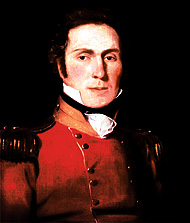
John Buchan, 1st Baron Tweedsmuir was a Scottish novelist, historian, and Unionist politician who served as Governor General of Canada, the 15th since Canadian Confederation.

Captain Patrick Logan was the commandant of the Moreton Bay Penal Settlement from 1826 until his death in 1830 at the hands of Aboriginal Australians who objected to him entering their lands. As he had been hated by convicts, there were rumours that escaped convicts living in the bush had attacked him, but there is no evidence of this.

Nahanni National Park Reserve in the Dehcho Region of the Northwest Territories, Canada, approximately 500 km (311 mi) west of Yellowknife, protects a portion of the Mackenzie Mountains Natural Region. The centrepiece of the park is the South Nahanni River. Four noteworthy canyons reaching 1,000 m (3,300 ft) in depth, called First, Second, Third and Fourth Canyon, line its whitewater river. The name Nahanni comes from the indigenous Dene language name for the area; Nahʔa Dehé, which means "river of the land of the Nahʔa people". The park was among the world's first four natural heritage locations to be inscribed as World Heritage Sites by UNESCO in 1978 because of its picturesque wild rivers, canyons, and waterfalls. The park is also said to be haunted or cursed, following the mysterious disappearances and deaths of several gold prospectors over the years.
Major-General Sir Richard Hannay, KCB, OBE, DSO, is a fictional character created by Scottish novelist John Buchan and further made popular by the 1935 Alfred Hitchcock film The 39 Steps, very loosely based on Buchan's 1915 novel of the same name. In his autobiography, Memory Hold-the-Door, Buchan suggests that the character is based, in part, on Edmund Ironside, from Edinburgh, a spy during the Second Boer War.

Susan Charlotte Buchan, Baroness Tweedsmuir was a British writer and the wife of author John Buchan. Between 1935 and 1940 she was viceregal consort of Canada while her husband was the governor general. She was also the author of several novels, children's books, and biographies, some of which were published under the name Susan Tweedsmuir.
Mountain Meadow may refer to:

John Macnab is a novel by John Buchan, published in 1925.
The Power-House is a novel by John Buchan, a thriller set in London, England. It was written in 1913, when it was serialised in Blackwood's Magazine, and it was published in book form in 1916. The narrator is the barrister and Tory MP Edward Leithen, who features in a number of Buchan's novels. The urban setting contrasts with that of its sequel, John Macnab, which is set in the Scottish Highlands.
Sir Edward Leithen is a fictional character in several of John Buchan's novels: The Power-House, John Macnab, The Dancing Floor, The Gap in the Curtain and Sick Heart River. These were published over a number of years, the first in 1916, and the last in 1941, one year after Buchan's death. Leithen's name is borrowed from the Leithen Water, a tributary of the River Tweed, one of many references to the Scottish Borders in Buchan's novels.

The Dancing Floor is a 1926 novel by John Buchan featuring Edward Leithen. It is the third of five novels written about the character of Leithen.

The Gap in the Curtain is a 1932 borderline science fiction novel by the Scottish author John Buchan. Part of the action is autobiographical, featuring the agonies of a contemporary up-and-coming politician. It explores the theory of serial time put forward by J W Dunne: Buchan had been reading An Experiment with Time.

Roland Pertwee was an English playwright, film and television screenwriter, director and actor. He was the father of Doctor Who actor Jon Pertwee and playwright and screenwriter Michael Pertwee. He was also the second cousin of actor Bill Pertwee and grandfather of actors Sean Pertwee and Dariel Pertwee.
John Palliser-Yeates was a fictional character created by John Buchan. He appeared in several Buchan novels, notably John Macnab.
Sir Archibald Roylance was a fictional character created by John Buchan. He appeared in many Buchan novels although never as the protagonist. He was a good friend of Richard Hannay and Edward Leithen despite being younger than them.

The Half-Hearted is a 1900 novel of romance and adventure by the Scottish author John Buchan. It was Buchan's first novel in a modern setting and was written when he was 24 while working for an All-Souls fellowship and reading for the bar.

Sir Quixote of the Moors: being some account of an episode in the life of the Sieur de Rohaine is an 1895 short novel by the Scottish author John Buchan. It was Buchan's first novel, written when he was nineteen and an undergraduate at Glasgow University. Buchan's original title was Sir Quixote, and he was annoyed by the addition of "of the Moors" by his publisher.

John Burnet of Barns is an 1898 novel by the Scottish author John Buchan, published when he was 23 years of age. His second novel, it had first appeared in serial form in Chambers’s Journal earlier that year.

The Runagates Club is a 1928 collection of short stories by the Scottish author John Buchan. The collection consists of twelve tales presented as reminiscences of members of The Runagates Club, a London dining society. Several of the stories are recounted by recurrent characters in Buchan’s fiction, including Richard Hannay, Sandy Arbuthnot, John Palliser-Yeates, Charles Lamancha, and Edward Leithen.
John George Haslette Vahey was a versatile and prolific Northern Irish author of detective fiction in the genre's Golden Age in the 1920s and 1930s. Although his work has remained largely out of print since the end of the golden age, he is now enjoying a resurgence of popularity, and some of his work is again in print, or available as e-books.












